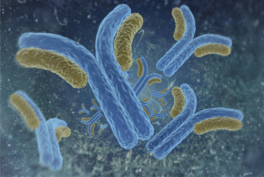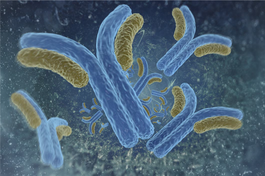Cayman
Showing 20251–20400 of 45550 results
-
Etofibrate is a combination of niacin and clofibrate (Item No. 10956) that acts as a hypolipidemic agent.{39206} In vivo, etofibrate decreases plasma cholesterol and triglyceride concentrations and increases bile cholesterol content in rats.{39206,39207} It also decreases thromboxane formation, platelet aggregation, and plasma viscosity and inhibits neointima formation in a carotid artery balloon injury rat model.{39208} Formulations containing etofibrate have been used to treat hyperlipidemia.
Brand:CaymanSKU:21022 -Out of stock
Etofibrate is a combination of niacin and clofibrate (Item No. 10956) that acts as a hypolipidemic agent.{39206} In vivo, etofibrate decreases plasma cholesterol and triglyceride concentrations and increases bile cholesterol content in rats.{39206,39207} It also decreases thromboxane formation, platelet aggregation, and plasma viscosity and inhibits neointima formation in a carotid artery balloon injury rat model.{39208} Formulations containing etofibrate have been used to treat hyperlipidemia.
Brand:CaymanSKU:21022 -Out of stock
Etofibrate is a combination of niacin and clofibrate (Item No. 10956) that acts as a hypolipidemic agent.{39206} In vivo, etofibrate decreases plasma cholesterol and triglyceride concentrations and increases bile cholesterol content in rats.{39206,39207} It also decreases thromboxane formation, platelet aggregation, and plasma viscosity and inhibits neointima formation in a carotid artery balloon injury rat model.{39208} Formulations containing etofibrate have been used to treat hyperlipidemia.
Brand:CaymanSKU:21022 -Out of stock
Etomidate (Item No. 21993) is an analytical reference standard that is categorized as an anesthetic. Formulations containing etomidate are used for general anesthesia and sedation.{34231} Etomidate also inhibits adrenal cortisol biosynthesis and mitigates hypercortisolism, as is found in Cushing syndrome.{34232,34233} This product is intended for research and forensic applications.
Brand:CaymanSKU:21993 -Out of stock
Etomidate (Item No. 21993) is an analytical reference standard that is categorized as an anesthetic. Formulations containing etomidate are used for general anesthesia and sedation.{34231} Etomidate also inhibits adrenal cortisol biosynthesis and mitigates hypercortisolism, as is found in Cushing syndrome.{34232,34233} This product is intended for research and forensic applications.
Brand:CaymanSKU:21993 -Out of stock
Etonogestrel is the biologically active metabolite of the prodrug desogestrel, a steroidal progestin.{12452} Etonogestrel is used in hormonal contraceptives, including implants and vaginal rings.{33168}
Brand:CaymanSKU:21062 -Out of stock
Etonogestrel is the biologically active metabolite of the prodrug desogestrel, a steroidal progestin.{12452} Etonogestrel is used in hormonal contraceptives, including implants and vaginal rings.{33168}
Brand:CaymanSKU:21062 -Out of stock
Etonogestrel is the biologically active metabolite of the prodrug desogestrel, a steroidal progestin.{12452} Etonogestrel is used in hormonal contraceptives, including implants and vaginal rings.{33168}
Brand:CaymanSKU:21062 -Out of stock
Etonogestrel is the biologically active metabolite of the prodrug desogestrel, a steroidal progestin.{12452} Etonogestrel is used in hormonal contraceptives, including implants and vaginal rings.{33168}
Brand:CaymanSKU:21062 -Out of stock
Etoposide is a plant alkaloid and an inhibitor of topoisomerase II (IC50 = 60.3 μM).{21619,21623} It inhibits proliferation of a variety of adenocarcinoma cells (IC50s = 0.005-12,200 µM) and human umbilical vein endothelial (HUVEC) cells (IC50 = 0.249 µM).{21620} It reduces tumor growth in an Ma human embryonal carcinoma mouse xenograft model when administered at a dose of 25 mg/kg, an effect that is enhanced by concomitant administration of the immunosuppressant cyclosporin A (Item No. 12088).{47188} Etoposide also inhibits nuclear receptor coactivator 3 (IC50 = 2.48 µM).{21622} Formulations containing etoposide have been used in combination therapy in the treatment of cancer.
Brand:CaymanSKU:12092 - 100 mgAvailable on backorder
Etoposide is a plant alkaloid and an inhibitor of topoisomerase II (IC50 = 60.3 μM).{21619,21623} It inhibits proliferation of a variety of adenocarcinoma cells (IC50s = 0.005-12,200 µM) and human umbilical vein endothelial (HUVEC) cells (IC50 = 0.249 µM).{21620} It reduces tumor growth in an Ma human embryonal carcinoma mouse xenograft model when administered at a dose of 25 mg/kg, an effect that is enhanced by concomitant administration of the immunosuppressant cyclosporin A (Item No. 12088).{47188} Etoposide also inhibits nuclear receptor coactivator 3 (IC50 = 2.48 µM).{21622} Formulations containing etoposide have been used in combination therapy in the treatment of cancer.
Brand:CaymanSKU:12092 - 25 mgAvailable on backorder
Etoposide is a plant alkaloid and an inhibitor of topoisomerase II (IC50 = 60.3 μM).{21619,21623} It inhibits proliferation of a variety of adenocarcinoma cells (IC50s = 0.005-12,200 µM) and human umbilical vein endothelial (HUVEC) cells (IC50 = 0.249 µM).{21620} It reduces tumor growth in an Ma human embryonal carcinoma mouse xenograft model when administered at a dose of 25 mg/kg, an effect that is enhanced by concomitant administration of the immunosuppressant cyclosporin A (Item No. 12088).{47188} Etoposide also inhibits nuclear receptor coactivator 3 (IC50 = 2.48 µM).{21622} Formulations containing etoposide have been used in combination therapy in the treatment of cancer.
Brand:CaymanSKU:12092 - 50 mgAvailable on backorder
Etoposide is a plant alkaloid and an inhibitor of topoisomerase II (IC50 = 60.3 μM).{21619,21623} It inhibits proliferation of a variety of adenocarcinoma cells (IC50s = 0.005-12,200 µM) and human umbilical vein endothelial (HUVEC) cells (IC50 = 0.249 µM).{21620} It reduces tumor growth in an Ma human embryonal carcinoma mouse xenograft model when administered at a dose of 25 mg/kg, an effect that is enhanced by concomitant administration of the immunosuppressant cyclosporin A (Item No. 12088).{47188} Etoposide also inhibits nuclear receptor coactivator 3 (IC50 = 2.48 µM).{21622} Formulations containing etoposide have been used in combination therapy in the treatment of cancer.
Brand:CaymanSKU:12092 - 500 mgAvailable on backorder
Etoricoxib is a dipyridinyl compound that demonstrates high in vitro and ex vivo selectivity for COX-2 over COX-1 in several assays, e.g., in the production of PGE2 by CHO cells expressing either COX-2 (IC50 = 79 nM) or COX-1 (IC50 > 50 µM).{11268,15425} Oral etoricoxib is well absorbed and metabolized extensively via oxidation, with metabolites excreted largely in the urine.{12837}
Brand:CaymanSKU:10091 - 10 mgAvailable on backorder
Etoricoxib is a dipyridinyl compound that demonstrates high in vitro and ex vivo selectivity for COX-2 over COX-1 in several assays, e.g., in the production of PGE2 by CHO cells expressing either COX-2 (IC50 = 79 nM) or COX-1 (IC50 > 50 µM).{11268,15425} Oral etoricoxib is well absorbed and metabolized extensively via oxidation, with metabolites excreted largely in the urine.{12837}
Brand:CaymanSKU:10091 - 100 mgAvailable on backorder
Etoricoxib is a dipyridinyl compound that demonstrates high in vitro and ex vivo selectivity for COX-2 over COX-1 in several assays, e.g., in the production of PGE2 by CHO cells expressing either COX-2 (IC50 = 79 nM) or COX-1 (IC50 > 50 µM).{11268,15425} Oral etoricoxib is well absorbed and metabolized extensively via oxidation, with metabolites excreted largely in the urine.{12837}
Brand:CaymanSKU:10091 - 250 mgAvailable on backorder
Etoricoxib is a dipyridinyl compound that demonstrates high in vitro and ex vivo selectivity for COX-2 over COX-1 in several assays, e.g., in the production of PGE2 by CHO cells expressing either COX-2 (IC50 = 79 nM) or COX-1 (IC50 > 50 µM).{11268,15425} Oral etoricoxib is well absorbed and metabolized extensively via oxidation, with metabolites excreted largely in the urine.{12837}
Brand:CaymanSKU:10091 - 50 mgAvailable on backorder
Etoxazole is an organofluorine acaricide.{43285,45079} It induces toxicity in two-spotted spider mite (T. urticae) larvae (LC50 = 0.036 mg/L for the London reference strain) through inhibition of chitin synthase 1. It reduces acetylcholinesterase (AChE) activity in the freshwater fish O. niloticus in a concentration-dependent manner.{45080} Etoxazole (2.2-22 mg/kg per day) inhibits the activity of catalase, glutathione peroxidase (GPX), and AChE in the liver and kidneys of rats in a dose-dependent manner.{45079} Formulations containing etoxazole have been used for the control of mites in agriculture.
Brand:CaymanSKU:25782 - 100 mgAvailable on backorder
Etoxazole is an organofluorine acaricide.{43285,45079} It induces toxicity in two-spotted spider mite (T. urticae) larvae (LC50 = 0.036 mg/L for the London reference strain) through inhibition of chitin synthase 1. It reduces acetylcholinesterase (AChE) activity in the freshwater fish O. niloticus in a concentration-dependent manner.{45080} Etoxazole (2.2-22 mg/kg per day) inhibits the activity of catalase, glutathione peroxidase (GPX), and AChE in the liver and kidneys of rats in a dose-dependent manner.{45079} Formulations containing etoxazole have been used for the control of mites in agriculture.
Brand:CaymanSKU:25782 - 25 mgAvailable on backorder
Etoxazole is an organofluorine acaricide.{43285,45079} It induces toxicity in two-spotted spider mite (T. urticae) larvae (LC50 = 0.036 mg/L for the London reference strain) through inhibition of chitin synthase 1. It reduces acetylcholinesterase (AChE) activity in the freshwater fish O. niloticus in a concentration-dependent manner.{45080} Etoxazole (2.2-22 mg/kg per day) inhibits the activity of catalase, glutathione peroxidase (GPX), and AChE in the liver and kidneys of rats in a dose-dependent manner.{45079} Formulations containing etoxazole have been used for the control of mites in agriculture.
Brand:CaymanSKU:25782 - 50 mgAvailable on backorder
ETP-46464 is an inhibitor of the DNA damage response kinase Ataxia-telangiectasia mutated (ATM)- and Rad3-related (ATR) with an IC50 value of 25 nM.{31719} It also inhibits mTOR and DNA-dependent protein kinase (IC50s = 0.6 and 36 nM, respectively), and is moderately active against PI3Kα and ATM (IC50s = 170 and 545 nM, respectively).{31719} Pharmacological inhibition of ATR is reported to generate replicative stress, leading to chromosomal breakage in the presence of conditions that stall replication forks.{31719} ETP-46464 has been shown to be toxic to p53-deficient cells, which is exacerbated by replicative stress-generating conditions such as the overexpression of cyclin E.{31719}
Brand:CaymanSKU:19809 -Available on backorder
ETP-46464 is an inhibitor of the DNA damage response kinase Ataxia-telangiectasia mutated (ATM)- and Rad3-related (ATR) with an IC50 value of 25 nM.{31719} It also inhibits mTOR and DNA-dependent protein kinase (IC50s = 0.6 and 36 nM, respectively), and is moderately active against PI3Kα and ATM (IC50s = 170 and 545 nM, respectively).{31719} Pharmacological inhibition of ATR is reported to generate replicative stress, leading to chromosomal breakage in the presence of conditions that stall replication forks.{31719} ETP-46464 has been shown to be toxic to p53-deficient cells, which is exacerbated by replicative stress-generating conditions such as the overexpression of cyclin E.{31719}
Brand:CaymanSKU:19809 -Available on backorder
ETP-46464 is an inhibitor of the DNA damage response kinase Ataxia-telangiectasia mutated (ATM)- and Rad3-related (ATR) with an IC50 value of 25 nM.{31719} It also inhibits mTOR and DNA-dependent protein kinase (IC50s = 0.6 and 36 nM, respectively), and is moderately active against PI3Kα and ATM (IC50s = 170 and 545 nM, respectively).{31719} Pharmacological inhibition of ATR is reported to generate replicative stress, leading to chromosomal breakage in the presence of conditions that stall replication forks.{31719} ETP-46464 has been shown to be toxic to p53-deficient cells, which is exacerbated by replicative stress-generating conditions such as the overexpression of cyclin E.{31719}
Brand:CaymanSKU:19809 -Available on backorder
Etrasimod is an orally bioavailable and potent antagonist of sphingosine-1-phosphate (S1P) receptors with EC50 values of 0.093, 0.44, 0.32, 0.34, and 0.32 nM for human, mouse, rat, dog, and monkey S1P1 receptors.{41302} It is selective for S1P1, S1P4, and S1P5 receptors with EC50 values of 6.1, >10,000, >10,000, 147, and 24.4 nM for S1P1-5, respectively, in a β-arrestin assay. Etrasimod (1 mg/kg, i.v.) decreases peripheral lymphocytes in mouse, rat, dog, and monkey (IC50s = 101, 51, 58, and 98 nM, respectively). It delays or prevents the onset and severity of murine experimental autoimmune encephalomyelitis (EAE) when administered at 0.3, 1, or 3 mg/kg. It also leads to lower EAE disease scores relative to vehicle when administered after disease onset and is efficacious in a rat model of collagen-induced arthritis.
Brand:CaymanSKU:21661 -Out of stock
Etrasimod is an orally bioavailable and potent antagonist of sphingosine-1-phosphate (S1P) receptors with EC50 values of 0.093, 0.44, 0.32, 0.34, and 0.32 nM for human, mouse, rat, dog, and monkey S1P1 receptors.{41302} It is selective for S1P1, S1P4, and S1P5 receptors with EC50 values of 6.1, >10,000, >10,000, 147, and 24.4 nM for S1P1-5, respectively, in a β-arrestin assay. Etrasimod (1 mg/kg, i.v.) decreases peripheral lymphocytes in mouse, rat, dog, and monkey (IC50s = 101, 51, 58, and 98 nM, respectively). It delays or prevents the onset and severity of murine experimental autoimmune encephalomyelitis (EAE) when administered at 0.3, 1, or 3 mg/kg. It also leads to lower EAE disease scores relative to vehicle when administered after disease onset and is efficacious in a rat model of collagen-induced arthritis.
Brand:CaymanSKU:21661 -Out of stock
Etrasimod is an orally bioavailable and potent antagonist of sphingosine-1-phosphate (S1P) receptors with EC50 values of 0.093, 0.44, 0.32, 0.34, and 0.32 nM for human, mouse, rat, dog, and monkey S1P1 receptors.{41302} It is selective for S1P1, S1P4, and S1P5 receptors with EC50 values of 6.1, >10,000, >10,000, 147, and 24.4 nM for S1P1-5, respectively, in a β-arrestin assay. Etrasimod (1 mg/kg, i.v.) decreases peripheral lymphocytes in mouse, rat, dog, and monkey (IC50s = 101, 51, 58, and 98 nM, respectively). It delays or prevents the onset and severity of murine experimental autoimmune encephalomyelitis (EAE) when administered at 0.3, 1, or 3 mg/kg. It also leads to lower EAE disease scores relative to vehicle when administered after disease onset and is efficacious in a rat model of collagen-induced arthritis.
Brand:CaymanSKU:21661 -Out of stock
Etrasimod is an orally bioavailable and potent antagonist of sphingosine-1-phosphate (S1P) receptors with EC50 values of 0.093, 0.44, 0.32, 0.34, and 0.32 nM for human, mouse, rat, dog, and monkey S1P1 receptors.{41302} It is selective for S1P1, S1P4, and S1P5 receptors with EC50 values of 6.1, >10,000, >10,000, 147, and 24.4 nM for S1P1-5, respectively, in a β-arrestin assay. Etrasimod (1 mg/kg, i.v.) decreases peripheral lymphocytes in mouse, rat, dog, and monkey (IC50s = 101, 51, 58, and 98 nM, respectively). It delays or prevents the onset and severity of murine experimental autoimmune encephalomyelitis (EAE) when administered at 0.3, 1, or 3 mg/kg. It also leads to lower EAE disease scores relative to vehicle when administered after disease onset and is efficacious in a rat model of collagen-induced arthritis.
Brand:CaymanSKU:21661 -Out of stock
Etravirine is a non-nucleoside reverse transcriptase inhibitor (NNRTI).{32936} It is active against the wild-type HIV-1 strains LAI, SF2, and Ba-L (EC50s = 1.4-4.8 nM) but not the HIV-2 strain ROD (EC50 = 3,479 nM). Etravirine is also active against 18 HIV-1 strains carrrying NNRTI resistance-associated mutations (EC50s = <5 nM). Etravirine (5 μM) increases intracellular processing of the viral polyproteins Gag and Gag-Pol and decreases viral particle production in HEK293T cells transfected with a plasmid encoding the NL4.3 infectious molecular clone of HIV-1.{32937} Formulations containing etravirine have been used in the treatment of HIV-1 infection.
Brand:CaymanSKU:20946 -Out of stock
Etravirine is a non-nucleoside reverse transcriptase inhibitor (NNRTI).{32936} It is active against the wild-type HIV-1 strains LAI, SF2, and Ba-L (EC50s = 1.4-4.8 nM) but not the HIV-2 strain ROD (EC50 = 3,479 nM). Etravirine is also active against 18 HIV-1 strains carrrying NNRTI resistance-associated mutations (EC50s = <5 nM). Etravirine (5 μM) increases intracellular processing of the viral polyproteins Gag and Gag-Pol and decreases viral particle production in HEK293T cells transfected with a plasmid encoding the NL4.3 infectious molecular clone of HIV-1.{32937} Formulations containing etravirine have been used in the treatment of HIV-1 infection.
Brand:CaymanSKU:20946 -Out of stock
Etravirine is a non-nucleoside reverse transcriptase inhibitor (NNRTI).{32936} It is active against the wild-type HIV-1 strains LAI, SF2, and Ba-L (EC50s = 1.4-4.8 nM) but not the HIV-2 strain ROD (EC50 = 3,479 nM). Etravirine is also active against 18 HIV-1 strains carrrying NNRTI resistance-associated mutations (EC50s = <5 nM). Etravirine (5 μM) increases intracellular processing of the viral polyproteins Gag and Gag-Pol and decreases viral particle production in HEK293T cells transfected with a plasmid encoding the NL4.3 infectious molecular clone of HIV-1.{32937} Formulations containing etravirine have been used in the treatment of HIV-1 infection.
Brand:CaymanSKU:20946 -Out of stock
Etravirine is a non-nucleoside reverse transcriptase inhibitor (NNRTI).{32936} It is active against the wild-type HIV-1 strains LAI, SF2, and Ba-L (EC50s = 1.4-4.8 nM) but not the HIV-2 strain ROD (EC50 = 3,479 nM). Etravirine is also active against 18 HIV-1 strains carrrying NNRTI resistance-associated mutations (EC50s = <5 nM). Etravirine (5 μM) increases intracellular processing of the viral polyproteins Gag and Gag-Pol and decreases viral particle production in HEK293T cells transfected with a plasmid encoding the NL4.3 infectious molecular clone of HIV-1.{32937} Formulations containing etravirine have been used in the treatment of HIV-1 infection.
Brand:CaymanSKU:20946 -Out of stock
Etravirine-d6 is intended for use as an internal standard for the quantification of etravirine (Item No. 20946) by GC- or LC-MS. Etravirine is a non-nucleoside reverse transcriptase inhibitor (NNRTI).{32936} It is active against the wild-type HIV-1 strains LAI, SF2, and Ba-L (EC50s = 1.4-4.8 nM) but not the HIV-2 strain ROD (EC50 = 3,479 nM). Etravirine is also active against 18 HIV-1 strains carrrying NNRTI resistance-associated mutations (EC50s = <5 nM). Etravirine (5 μM) increases intracellular processing of the viral polyproteins Gag and Gag-Pol and decreases viral particle production in HEK293T cells transfected with a plasmid encoding the NL4.3 infectious molecular clone of HIV-1.{32937} Formulations containing etravirine have been used in the treatment of HIV-1 infection.
Brand:CaymanSKU:28902 - 1 mgAvailable on backorder
Etretinate is a second-generation retinoid previously used systemically to manage psoriasis but withdrawn due to teratogenicity.{32221,32224} Etretinate alters cAMP signaling, which may be defective in psoriasis.{32222,32223}
Brand:CaymanSKU:19878 -Available on backorder
Etretinate is a second-generation retinoid previously used systemically to manage psoriasis but withdrawn due to teratogenicity.{32221,32224} Etretinate alters cAMP signaling, which may be defective in psoriasis.{32222,32223}
Brand:CaymanSKU:19878 -Available on backorder
Etretinate is a second-generation retinoid previously used systemically to manage psoriasis but withdrawn due to teratogenicity.{32221,32224} Etretinate alters cAMP signaling, which may be defective in psoriasis.{32222,32223}
Brand:CaymanSKU:19878 -Available on backorder
Etretinate is a second-generation retinoid previously used systemically to manage psoriasis but withdrawn due to teratogenicity.{32221,32224} Etretinate alters cAMP signaling, which may be defective in psoriasis.{32222,32223}
Brand:CaymanSKU:19878 -Available on backorder
ETS is one of the largest family of TF (with 28 members in Human). Protein C-ets-1 is a protein that in humans is encoded by the ETS1. ETS1 is playing an important role in immune cells, and tissues. [Bertin Catalog No. G01013]
Brand:CaymanSKU:32771 - 100 µlAvailable on backorder
Brand:CaymanSKU:32771- 100 µlAvailable on backorder
Brand:CaymanSKU:32771- 100 µlETS is one of the largest family of TF (with 28 members in Human). Protein C-ets-1 is a protein that in humans is encoded by the ETS1. ETS1 is playing an important role in immune cells and tissues. [Bertin Catalog No. G01014]
Brand:CaymanSKU:32772 - 100 µlAvailable on backorder
Brand:CaymanSKU:32772- 100 µlAvailable on backorder
Brand:CaymanSKU:32772- 100 µlEucalyptol is a bicyclic monoterpene that has been found in Eucalyptus and other plants, including C. sativa and has diverse biological activities, including anti-inflammatory, decongestant, antinociceptive, and insect repellent properties.{21071,39875,39876,39877,39878} Eucalyptol (10 μM) inhibits TNF-α, IL-1β, IL-4, and IL-5 production by primary human lymphocytes stimulated by ionomycin (Item No. 10004974) and phorbol 12-myristate 13-acetate (PMA; Item No. 10008014).{39875} It also decreases LPS-induced mucus production by primary human nasal turbinate slices when used at a concentration of 10 μM.{39876} Eucalyptol (400 mg/kg) decreases carrageenan-induced hind paw edema in rats and reduces the time spent licking the hind paw in a formalin-induced nociception test in mice.{39877} It inhibits A. aegypti mosquitoes from feeding on anesthetized gerbils when applied topically at a concentration of 10% and from laying eggs in an ovipositional bioassay when used at a concentration of 1% in standing water.{39878} Formulations containing eucalyptol have been used in mouthwash and cough suppressants.
Brand:CaymanSKU:22183 -Out of stock
Eucalyptol is a bicyclic monoterpene that has been found in Eucalyptus and other plants, including C. sativa and has diverse biological activities, including anti-inflammatory, decongestant, antinociceptive, and insect repellent properties.{21071,39875,39876,39877,39878} Eucalyptol (10 μM) inhibits TNF-α, IL-1β, IL-4, and IL-5 production by primary human lymphocytes stimulated by ionomycin (Item No. 10004974) and phorbol 12-myristate 13-acetate (PMA; Item No. 10008014).{39875} It also decreases LPS-induced mucus production by primary human nasal turbinate slices when used at a concentration of 10 μM.{39876} Eucalyptol (400 mg/kg) decreases carrageenan-induced hind paw edema in rats and reduces the time spent licking the hind paw in a formalin-induced nociception test in mice.{39877} It inhibits A. aegypti mosquitoes from feeding on anesthetized gerbils when applied topically at a concentration of 10% and from laying eggs in an ovipositional bioassay when used at a concentration of 1% in standing water.{39878} Formulations containing eucalyptol have been used in mouthwash and cough suppressants.
Brand:CaymanSKU:22183 -Out of stock
Eucalyptol is a bicyclic monoterpene that has been found in Eucalyptus and other plants, including C. sativa and has diverse biological activities, including anti-inflammatory, decongestant, antinociceptive, and insect repellent properties.{21071,39875,39876,39877,39878} Eucalyptol (10 μM) inhibits TNF-α, IL-1β, IL-4, and IL-5 production by primary human lymphocytes stimulated by ionomycin (Item No. 10004974) and phorbol 12-myristate 13-acetate (PMA; Item No. 10008014).{39875} It also decreases LPS-induced mucus production by primary human nasal turbinate slices when used at a concentration of 10 μM.{39876} Eucalyptol (400 mg/kg) decreases carrageenan-induced hind paw edema in rats and reduces the time spent licking the hind paw in a formalin-induced nociception test in mice.{39877} It inhibits A. aegypti mosquitoes from feeding on anesthetized gerbils when applied topically at a concentration of 10% and from laying eggs in an ovipositional bioassay when used at a concentration of 1% in standing water.{39878} Formulations containing eucalyptol have been used in mouthwash and cough suppressants.
Brand:CaymanSKU:22183 -Out of stock
Eucalyptol is a bicyclic monoterpene that has been found in Eucalyptus and other plants, including C. sativa and has diverse biological activities, including anti-inflammatory, decongestant, antinociceptive, and insect repellent properties.{21071,39875,39876,39877,39878} Eucalyptol (10 μM) inhibits TNF-α, IL-1β, IL-4, and IL-5 production by primary human lymphocytes stimulated by ionomycin (Item No. 10004974) and phorbol 12-myristate 13-acetate (PMA; Item No. 10008014).{39875} It also decreases LPS-induced mucus production by primary human nasal turbinate slices when used at a concentration of 10 μM.{39876} Eucalyptol (400 mg/kg) decreases carrageenan-induced hind paw edema in rats and reduces the time spent licking the hind paw in a formalin-induced nociception test in mice.{39877} It inhibits A. aegypti mosquitoes from feeding on anesthetized gerbils when applied topically at a concentration of 10% and from laying eggs in an ovipositional bioassay when used at a concentration of 1% in standing water.{39878} Formulations containing eucalyptol have been used in mouthwash and cough suppressants.
Brand:CaymanSKU:22183 -Out of stock
EUK 8 and EUK 134 (Item No. 10006329) are synthetic catalytic scavengers of reactive oxygen species with superoxide dismutase (SOD) and catalase mimetic activity.{12345} EUK 118 is a structural analog of EUK 8 and EUK 134 with significantly reduced activity. EUK 118 exhibits a catalase activity of 35 µM O2 formed/minute from 10 mM hydrogen peroxide, which is more than four times lower that that observed for EUK 8 under the same conditions.{16020} Superoxide-mediated reduction of an electron acceptor (i.e., SOD mimetic activity) was inhibited by EUK 118 and EUK 8 with IC50 values of 2 and 0.7 µM, respectively. EUK 118 did not protect human dermal fibroblasts against hydrogen peroxide-induced cell death.{16020}
Brand:CaymanSKU:10271 - 10 mgAvailable on backorder
EUK 8 and EUK 134 (Item No. 10006329) are synthetic catalytic scavengers of reactive oxygen species with superoxide dismutase (SOD) and catalase mimetic activity.{12345} EUK 118 is a structural analog of EUK 8 and EUK 134 with significantly reduced activity. EUK 118 exhibits a catalase activity of 35 µM O2 formed/minute from 10 mM hydrogen peroxide, which is more than four times lower that that observed for EUK 8 under the same conditions.{16020} Superoxide-mediated reduction of an electron acceptor (i.e., SOD mimetic activity) was inhibited by EUK 118 and EUK 8 with IC50 values of 2 and 0.7 µM, respectively. EUK 118 did not protect human dermal fibroblasts against hydrogen peroxide-induced cell death.{16020}
Brand:CaymanSKU:10271 - 5 mgAvailable on backorder
EUK 8 and EUK 134 (Item No. 10006329) are synthetic catalytic scavengers of reactive oxygen species with superoxide dismutase (SOD) and catalase mimetic activity.{12345} EUK 118 is a structural analog of EUK 8 and EUK 134 with significantly reduced activity. EUK 118 exhibits a catalase activity of 35 µM O2 formed/minute from 10 mM hydrogen peroxide, which is more than four times lower that that observed for EUK 8 under the same conditions.{16020} Superoxide-mediated reduction of an electron acceptor (i.e., SOD mimetic activity) was inhibited by EUK 118 and EUK 8 with IC50 values of 2 and 0.7 µM, respectively. EUK 118 did not protect human dermal fibroblasts against hydrogen peroxide-induced cell death.{16020}
Brand:CaymanSKU:10271 - 50 mgAvailable on backorder
EUK 8 and EUK 134 (Item No. 10006329) are synthetic catalytic scavengers of reactive oxygen species with superoxide dismutase (SOD) and catalase mimetic activity.{12345} EUK 124 is a structural analog of EUK 8 and EUK 134 with significantly reduced activity. EUK 124 and EUK 8 inhibit superoxide-mediated reduction of an electron acceptor (i.e., SOD mimetic activity), with IC50 values of 5 µM and 0.7 µM, respectively.{16020}
Brand:CaymanSKU:12500 - 10 mgAvailable on backorder
EUK 8 and EUK 134 (Item No. 10006329) are synthetic catalytic scavengers of reactive oxygen species with superoxide dismutase (SOD) and catalase mimetic activity.{12345} EUK 124 is a structural analog of EUK 8 and EUK 134 with significantly reduced activity. EUK 124 and EUK 8 inhibit superoxide-mediated reduction of an electron acceptor (i.e., SOD mimetic activity), with IC50 values of 5 µM and 0.7 µM, respectively.{16020}
Brand:CaymanSKU:12500 - 5 mgAvailable on backorder
Synthetic manganese-porphyrin complexes have been documented to act as scavengers for oxidative species such as peroxynitrite, superoxide, and hydrogen peroxide. EUK 134 is a salen-manganese complex that has been modified to increase its catalase activity while retaining SOD activity. EUK 134 is a salen-manganese complex that has been modified to increase its catalase activity while retaining SOD activity. EUK 134 consumes hydrogen peroxide with an initial reaction rate of 234 µM/min in vitro.{12345} EUK 134 is protective in a rat stroke model, employing middle cerebral artery ligation. At 2.5 mg/kg, rats treated with EUK 134 showed reduced infarct volume by more than 80%. EUK 134 at 10 mg/kg also significantly attenuates brain damage in rats following systemic administration of kainic acid.{12346}
Brand:CaymanSKU:10006329 - 10 mgAvailable on backorder
Synthetic manganese-porphyrin complexes have been documented to act as scavengers for oxidative species such as peroxynitrite, superoxide, and hydrogen peroxide. EUK 134 is a salen-manganese complex that has been modified to increase its catalase activity while retaining SOD activity. EUK 134 is a salen-manganese complex that has been modified to increase its catalase activity while retaining SOD activity. EUK 134 consumes hydrogen peroxide with an initial reaction rate of 234 µM/min in vitro.{12345} EUK 134 is protective in a rat stroke model, employing middle cerebral artery ligation. At 2.5 mg/kg, rats treated with EUK 134 showed reduced infarct volume by more than 80%. EUK 134 at 10 mg/kg also significantly attenuates brain damage in rats following systemic administration of kainic acid.{12346}
Brand:CaymanSKU:10006329 - 100 mgAvailable on backorder
Synthetic manganese-porphyrin complexes have been documented to act as scavengers for oxidative species such as peroxynitrite, superoxide, and hydrogen peroxide. EUK 134 is a salen-manganese complex that has been modified to increase its catalase activity while retaining SOD activity. EUK 134 is a salen-manganese complex that has been modified to increase its catalase activity while retaining SOD activity. EUK 134 consumes hydrogen peroxide with an initial reaction rate of 234 µM/min in vitro.{12345} EUK 134 is protective in a rat stroke model, employing middle cerebral artery ligation. At 2.5 mg/kg, rats treated with EUK 134 showed reduced infarct volume by more than 80%. EUK 134 at 10 mg/kg also significantly attenuates brain damage in rats following systemic administration of kainic acid.{12346}
Brand:CaymanSKU:10006329 - 5 mgAvailable on backorder
Synthetic manganese-porphyrin complexes have been documented to act as scavengers for oxidative species such as peroxynitrite, superoxide, and hydrogen peroxide. EUK 134 is a salen-manganese complex that has been modified to increase its catalase activity while retaining SOD activity. EUK 134 is a salen-manganese complex that has been modified to increase its catalase activity while retaining SOD activity. EUK 134 consumes hydrogen peroxide with an initial reaction rate of 234 µM/min in vitro.{12345} EUK 134 is protective in a rat stroke model, employing middle cerebral artery ligation. At 2.5 mg/kg, rats treated with EUK 134 showed reduced infarct volume by more than 80%. EUK 134 at 10 mg/kg also significantly attenuates brain damage in rats following systemic administration of kainic acid.{12346}
Brand:CaymanSKU:10006329 - 50 mgAvailable on backorder
Eupatilin is a flavonoid that has been found in Artemisia and has diverse biological activities.{31454,31451,31453,61041,61042} It inhibits cell growth in A375 melanoma cells when used at concentrations ranging from 25 to 800 µM.{31454} Eupatilin binds to peroxisome proliferator-activated receptor α (PPARα; IC50 = 1.18 µM) and induces reporter gene expression in CV-1 cells expressing human PPARα, but not PPARγ, when used at concentrations ranging from 10 to 300 µM.{31451} It prevents hydrogen peroxide-induced disruption of the F-actin cytoskeleton and inhibition of cell migration in AGS gastric epithelial cells.{31452} Eupatilin also inhibits 5-lipoxygenase (5-LO) activity in cultured mastocytoma cells (IC50 = 14 µM).{31453} In vivo, eupatilin (5, 10, and 15 mg/kg) reduces pulmonary edema and levels of the lung injury markers surfactant protein A (SPA) and SPD in a rat model of LPS-induced acute lung injury.{61041} It reduces serum levels of histamine and increases survival in a mouse model of allergic anaphylactic shock induced by compound 48/80 (Item No. 22173).{61042}
Brand:CaymanSKU:19601 -Available on backorder
Eupatilin is a flavonoid that has been found in Artemisia and has diverse biological activities.{31454,31451,31453,61041,61042} It inhibits cell growth in A375 melanoma cells when used at concentrations ranging from 25 to 800 µM.{31454} Eupatilin binds to peroxisome proliferator-activated receptor α (PPARα; IC50 = 1.18 µM) and induces reporter gene expression in CV-1 cells expressing human PPARα, but not PPARγ, when used at concentrations ranging from 10 to 300 µM.{31451} It prevents hydrogen peroxide-induced disruption of the F-actin cytoskeleton and inhibition of cell migration in AGS gastric epithelial cells.{31452} Eupatilin also inhibits 5-lipoxygenase (5-LO) activity in cultured mastocytoma cells (IC50 = 14 µM).{31453} In vivo, eupatilin (5, 10, and 15 mg/kg) reduces pulmonary edema and levels of the lung injury markers surfactant protein A (SPA) and SPD in a rat model of LPS-induced acute lung injury.{61041} It reduces serum levels of histamine and increases survival in a mouse model of allergic anaphylactic shock induced by compound 48/80 (Item No. 22173).{61042}
Brand:CaymanSKU:19601 -Available on backorder
Eupatilin is a flavonoid that has been found in Artemisia and has diverse biological activities.{31454,31451,31453,61041,61042} It inhibits cell growth in A375 melanoma cells when used at concentrations ranging from 25 to 800 µM.{31454} Eupatilin binds to peroxisome proliferator-activated receptor α (PPARα; IC50 = 1.18 µM) and induces reporter gene expression in CV-1 cells expressing human PPARα, but not PPARγ, when used at concentrations ranging from 10 to 300 µM.{31451} It prevents hydrogen peroxide-induced disruption of the F-actin cytoskeleton and inhibition of cell migration in AGS gastric epithelial cells.{31452} Eupatilin also inhibits 5-lipoxygenase (5-LO) activity in cultured mastocytoma cells (IC50 = 14 µM).{31453} In vivo, eupatilin (5, 10, and 15 mg/kg) reduces pulmonary edema and levels of the lung injury markers surfactant protein A (SPA) and SPD in a rat model of LPS-induced acute lung injury.{61041} It reduces serum levels of histamine and increases survival in a mouse model of allergic anaphylactic shock induced by compound 48/80 (Item No. 22173).{61042}
Brand:CaymanSKU:19601 -Available on backorder
Eupatilin is a flavonoid that has been found in Artemisia and has diverse biological activities.{31454,31451,31453,61041,61042} It inhibits cell growth in A375 melanoma cells when used at concentrations ranging from 25 to 800 µM.{31454} Eupatilin binds to peroxisome proliferator-activated receptor α (PPARα; IC50 = 1.18 µM) and induces reporter gene expression in CV-1 cells expressing human PPARα, but not PPARγ, when used at concentrations ranging from 10 to 300 µM.{31451} It prevents hydrogen peroxide-induced disruption of the F-actin cytoskeleton and inhibition of cell migration in AGS gastric epithelial cells.{31452} Eupatilin also inhibits 5-lipoxygenase (5-LO) activity in cultured mastocytoma cells (IC50 = 14 µM).{31453} In vivo, eupatilin (5, 10, and 15 mg/kg) reduces pulmonary edema and levels of the lung injury markers surfactant protein A (SPA) and SPD in a rat model of LPS-induced acute lung injury.{61041} It reduces serum levels of histamine and increases survival in a mouse model of allergic anaphylactic shock induced by compound 48/80 (Item No. 22173).{61042}
Brand:CaymanSKU:19601 -Available on backorder
Eupatorin is a flavonoid that has been found in L. camara and has diverse biological activities.{53322,53323,53324,53325} It inhibits the growth of HeLa, MK-1, and B16/F10 tumor cells (GI50s = 15, 58, and 44 µM, respectively).{53322} Eupatorin is active against T. cruzi epimastigotes and trypomastigotes (IC50s = 0.2 and 61.8 µg/ml, respectively) without inducing cytotoxicity in Vero cells (IC50 = >500 µg/ml).{53323} It induces vasorelaxation in isolated rat thoracic aortic rings precontracted with phenylephrine (pD2 = 6.66).{53324} Eupatorin (10 and 100 µM) reduces nuclear translocation of NF-κB and STAT1α in J774 murine macrophages and reduces paw edema in a mouse model of carrageenan-induced paw inflammation when administered at a dose of 50 mg/kg.{53325}
Brand:CaymanSKU:29599 - 10 mgAvailable on backorder
Eupatorin is a flavonoid that has been found in L. camara and has diverse biological activities.{53322,53323,53324,53325} It inhibits the growth of HeLa, MK-1, and B16/F10 tumor cells (GI50s = 15, 58, and 44 µM, respectively).{53322} Eupatorin is active against T. cruzi epimastigotes and trypomastigotes (IC50s = 0.2 and 61.8 µg/ml, respectively) without inducing cytotoxicity in Vero cells (IC50 = >500 µg/ml).{53323} It induces vasorelaxation in isolated rat thoracic aortic rings precontracted with phenylephrine (pD2 = 6.66).{53324} Eupatorin (10 and 100 µM) reduces nuclear translocation of NF-κB and STAT1α in J774 murine macrophages and reduces paw edema in a mouse model of carrageenan-induced paw inflammation when administered at a dose of 50 mg/kg.{53325}
Brand:CaymanSKU:29599 - 100 mgAvailable on backorder
Eupatorin is a flavonoid that has been found in L. camara and has diverse biological activities.{53322,53323,53324,53325} It inhibits the growth of HeLa, MK-1, and B16/F10 tumor cells (GI50s = 15, 58, and 44 µM, respectively).{53322} Eupatorin is active against T. cruzi epimastigotes and trypomastigotes (IC50s = 0.2 and 61.8 µg/ml, respectively) without inducing cytotoxicity in Vero cells (IC50 = >500 µg/ml).{53323} It induces vasorelaxation in isolated rat thoracic aortic rings precontracted with phenylephrine (pD2 = 6.66).{53324} Eupatorin (10 and 100 µM) reduces nuclear translocation of NF-κB and STAT1α in J774 murine macrophages and reduces paw edema in a mouse model of carrageenan-induced paw inflammation when administered at a dose of 50 mg/kg.{53325}
Brand:CaymanSKU:29599 - 25 mgAvailable on backorder
Eupatorin is a flavonoid that has been found in L. camara and has diverse biological activities.{53322,53323,53324,53325} It inhibits the growth of HeLa, MK-1, and B16/F10 tumor cells (GI50s = 15, 58, and 44 µM, respectively).{53322} Eupatorin is active against T. cruzi epimastigotes and trypomastigotes (IC50s = 0.2 and 61.8 µg/ml, respectively) without inducing cytotoxicity in Vero cells (IC50 = >500 µg/ml).{53323} It induces vasorelaxation in isolated rat thoracic aortic rings precontracted with phenylephrine (pD2 = 6.66).{53324} Eupatorin (10 and 100 µM) reduces nuclear translocation of NF-κB and STAT1α in J774 murine macrophages and reduces paw edema in a mouse model of carrageenan-induced paw inflammation when administered at a dose of 50 mg/kg.{53325}
Brand:CaymanSKU:29599 - 50 mgAvailable on backorder
Eupenifeldin is a pentacyclic bistropolone fungal metabolite originally isolated from E. brefeldianum ATCC 74184.{39755} It is cytotoxic against HCT116 and HCTVM46 colon carcinoma cells in vitro (IC50s = 0.005 and 0.002 μg/ml, respectively). In vivo, eupenifeldin (0.3-2 mg/kg per day) increases median survival time in a mouse model of P388 leukemia.
Brand:CaymanSKU:25114 - 100 µgAvailable on backorder
Eupenifeldin is a pentacyclic bistropolone fungal metabolite originally isolated from E. brefeldianum ATCC 74184.{39755} It is cytotoxic against HCT116 and HCTVM46 colon carcinoma cells in vitro (IC50s = 0.005 and 0.002 μg/ml, respectively). In vivo, eupenifeldin (0.3-2 mg/kg per day) increases median survival time in a mouse model of P388 leukemia.
Brand:CaymanSKU:25114 - 500 µgAvailable on backorder
Euphol acetate is a triterpenoid that has been found in Euphorbia species and has diverse biological activities.{48815,48816,48817} It reduces sodium fluorescein uptake by CHO cells expressing organic anion-transporting polypeptide 1B1 (OATP1B1) and OATP1B3 to 29.2 and 40.2% of controls, respectively, when used at a concentration of 10 μM.{48817} Euphol acetate (50 and 100 μg/ml) induces mortality in 40% of B. glabrata snails.{48816}
Brand:CaymanSKU:29646 - 1 mgAvailable on backorder
Euphorbiasteroid is a tricyclic diterpene that has been found in the plant E. lathyris.{48442} It inhibits early-stage adipogenesis of 3T3-L1 cells, decreasing intracellular triglyceride accumulation when used at concentrations of 25 and 50 µM.{48443} It decreases the expression of Fas, C/EBPα, PPARγ, and SREBP-1c and increases phosphorylation of AMP-activated protein kinase (AMPK) and acetyl-coenzyme A carboxylase (ACC) in 3T3-L1 cells. Euphorbiasteroid inhibits proliferation of HL-60 cells in a concentration-dependent manner, as well as induces apoptosis and increases the expression of Fas and Fas ligand (FasL) and the activity of caspase-3 and caspase-8 in HL-60 cells.{48444} It increases P-glycoprotein activity, reverses multi-drug resistance, and restores cytotoxicity of the anticancer agents vinblastine (Item No. 11762), paclitaxel (Item No. 10461), and doxorubicin (Item No. 15007) to MES-SA/Dx5 sarcoma cells.{48445}
Brand:CaymanSKU:27822 - 100 mgAvailable on backorder
Euphorbiasteroid is a tricyclic diterpene that has been found in the plant E. lathyris.{48442} It inhibits early-stage adipogenesis of 3T3-L1 cells, decreasing intracellular triglyceride accumulation when used at concentrations of 25 and 50 µM.{48443} It decreases the expression of Fas, C/EBPα, PPARγ, and SREBP-1c and increases phosphorylation of AMP-activated protein kinase (AMPK) and acetyl-coenzyme A carboxylase (ACC) in 3T3-L1 cells. Euphorbiasteroid inhibits proliferation of HL-60 cells in a concentration-dependent manner, as well as induces apoptosis and increases the expression of Fas and Fas ligand (FasL) and the activity of caspase-3 and caspase-8 in HL-60 cells.{48444} It increases P-glycoprotein activity, reverses multi-drug resistance, and restores cytotoxicity of the anticancer agents vinblastine (Item No. 11762), paclitaxel (Item No. 10461), and doxorubicin (Item No. 15007) to MES-SA/Dx5 sarcoma cells.{48445}
Brand:CaymanSKU:27822 - 25 mgAvailable on backorder
Euphorbiasteroid is a tricyclic diterpene that has been found in the plant E. lathyris.{48442} It inhibits early-stage adipogenesis of 3T3-L1 cells, decreasing intracellular triglyceride accumulation when used at concentrations of 25 and 50 µM.{48443} It decreases the expression of Fas, C/EBPα, PPARγ, and SREBP-1c and increases phosphorylation of AMP-activated protein kinase (AMPK) and acetyl-coenzyme A carboxylase (ACC) in 3T3-L1 cells. Euphorbiasteroid inhibits proliferation of HL-60 cells in a concentration-dependent manner, as well as induces apoptosis and increases the expression of Fas and Fas ligand (FasL) and the activity of caspase-3 and caspase-8 in HL-60 cells.{48444} It increases P-glycoprotein activity, reverses multi-drug resistance, and restores cytotoxicity of the anticancer agents vinblastine (Item No. 11762), paclitaxel (Item No. 10461), and doxorubicin (Item No. 15007) to MES-SA/Dx5 sarcoma cells.{48445}
Brand:CaymanSKU:27822 - 250 mgAvailable on backorder
Euphorbiasteroid is a tricyclic diterpene that has been found in the plant E. lathyris.{48442} It inhibits early-stage adipogenesis of 3T3-L1 cells, decreasing intracellular triglyceride accumulation when used at concentrations of 25 and 50 µM.{48443} It decreases the expression of Fas, C/EBPα, PPARγ, and SREBP-1c and increases phosphorylation of AMP-activated protein kinase (AMPK) and acetyl-coenzyme A carboxylase (ACC) in 3T3-L1 cells. Euphorbiasteroid inhibits proliferation of HL-60 cells in a concentration-dependent manner, as well as induces apoptosis and increases the expression of Fas and Fas ligand (FasL) and the activity of caspase-3 and caspase-8 in HL-60 cells.{48444} It increases P-glycoprotein activity, reverses multi-drug resistance, and restores cytotoxicity of the anticancer agents vinblastine (Item No. 11762), paclitaxel (Item No. 10461), and doxorubicin (Item No. 15007) to MES-SA/Dx5 sarcoma cells.{48445}
Brand:CaymanSKU:27822 - 50 mgAvailable on backorder
Eurycomanone is a quassinoid originally isolated from E. longifolia that has diverse biological activities.{59000} It is active against the W2 and D6 clones of P. falciparum (IC50s = 0.015 and 0.026 µg/ml, respectively).{59002} Eurycomanone induces lipolysis in 3T3-L1 adipocytes with an EC50 value of 14.6 µM, an effect that can be blocked by the protein kinase A (PKA) inhibitor H-89 (Item No. 10010556).{59001} It induces cell cycle arrest at the G2/M phase and apoptosis in HepG2 cells when used at a concentration of 5 µg/ml.{59003} It reduces estrogen release and increases testosterone release in isolated rat Leydig cell-rich testicular interstitial cell preparations when used at concentrations of 1 and 10 µM.{59004} Eurycomanone (1 mg/kg, i.p.) decreases gastric acid secretion and lesion size in rat models of indomethacin-, water immersion stress-, or pyloric ligation-induced ulcer formation.{59005}
Brand:CaymanSKU:30896 - 1 mgAvailable on backorder
Eurycomanone is a quassinoid originally isolated from E. longifolia that has diverse biological activities.{59000} It is active against the W2 and D6 clones of P. falciparum (IC50s = 0.015 and 0.026 µg/ml, respectively).{59002} Eurycomanone induces lipolysis in 3T3-L1 adipocytes with an EC50 value of 14.6 µM, an effect that can be blocked by the protein kinase A (PKA) inhibitor H-89 (Item No. 10010556).{59001} It induces cell cycle arrest at the G2/M phase and apoptosis in HepG2 cells when used at a concentration of 5 µg/ml.{59003} It reduces estrogen release and increases testosterone release in isolated rat Leydig cell-rich testicular interstitial cell preparations when used at concentrations of 1 and 10 µM.{59004} Eurycomanone (1 mg/kg, i.p.) decreases gastric acid secretion and lesion size in rat models of indomethacin-, water immersion stress-, or pyloric ligation-induced ulcer formation.{59005}
Brand:CaymanSKU:30896 - 10 mgAvailable on backorder
Eurycomanone is a quassinoid originally isolated from E. longifolia that has diverse biological activities.{59000} It is active against the W2 and D6 clones of P. falciparum (IC50s = 0.015 and 0.026 µg/ml, respectively).{59002} Eurycomanone induces lipolysis in 3T3-L1 adipocytes with an EC50 value of 14.6 µM, an effect that can be blocked by the protein kinase A (PKA) inhibitor H-89 (Item No. 10010556).{59001} It induces cell cycle arrest at the G2/M phase and apoptosis in HepG2 cells when used at a concentration of 5 µg/ml.{59003} It reduces estrogen release and increases testosterone release in isolated rat Leydig cell-rich testicular interstitial cell preparations when used at concentrations of 1 and 10 µM.{59004} Eurycomanone (1 mg/kg, i.p.) decreases gastric acid secretion and lesion size in rat models of indomethacin-, water immersion stress-, or pyloric ligation-induced ulcer formation.{59005}
Brand:CaymanSKU:30896 - 25 mgAvailable on backorder
Eurycomanone is a quassinoid originally isolated from E. longifolia that has diverse biological activities.{59000} It is active against the W2 and D6 clones of P. falciparum (IC50s = 0.015 and 0.026 µg/ml, respectively).{59002} Eurycomanone induces lipolysis in 3T3-L1 adipocytes with an EC50 value of 14.6 µM, an effect that can be blocked by the protein kinase A (PKA) inhibitor H-89 (Item No. 10010556).{59001} It induces cell cycle arrest at the G2/M phase and apoptosis in HepG2 cells when used at a concentration of 5 µg/ml.{59003} It reduces estrogen release and increases testosterone release in isolated rat Leydig cell-rich testicular interstitial cell preparations when used at concentrations of 1 and 10 µM.{59004} Eurycomanone (1 mg/kg, i.p.) decreases gastric acid secretion and lesion size in rat models of indomethacin-, water immersion stress-, or pyloric ligation-induced ulcer formation.{59005}
Brand:CaymanSKU:30896 - 5 mgAvailable on backorder
Evacetrapib is a benzazepine inhibitor of cholesteryl ester transfer protein (CETP; IC50s = 5.5 and 26 nM for human recombinant and plasma-derived proteins, respectively).{41797} It is selective for CETP over a panel of cell surface and nuclear receptors with no significant inhibition at 1 µM. Evacetrapib (1-10 µM) reduces expression of the serine protease proprotein convertase subtilisin kexin 9 (PCSK9) and the LDL receptor (LDLR) in HepG2 cells in a dose-dependent manner with no effect on cell viability.{41798} It also reduces protein levels of LDLR, SREBF2-M, and PCSK9 in HepG2 lysates, nuclear extracts, and culture medium, respectively, in a dose-dependent manner. Oral administration of evacetrapib (30 mg/kg) inhibits CETP activity by 98.5, 98.6, and 18.4% after four, eight, and 24 hours, respectively, in serum from transgenic mice expressing human CETP and ApoA1.{41797} Evacetrapib increases HDL cholesterol levels in CETP/ApoA1 transgenic mice in a dose-dependent manner, including by 129.7% eight hours following administration of a 30 mg/kg dose.
Brand:CaymanSKU:23670 - 10 mgAvailable on backorder
Evacetrapib is a benzazepine inhibitor of cholesteryl ester transfer protein (CETP; IC50s = 5.5 and 26 nM for human recombinant and plasma-derived proteins, respectively).{41797} It is selective for CETP over a panel of cell surface and nuclear receptors with no significant inhibition at 1 µM. Evacetrapib (1-10 µM) reduces expression of the serine protease proprotein convertase subtilisin kexin 9 (PCSK9) and the LDL receptor (LDLR) in HepG2 cells in a dose-dependent manner with no effect on cell viability.{41798} It also reduces protein levels of LDLR, SREBF2-M, and PCSK9 in HepG2 lysates, nuclear extracts, and culture medium, respectively, in a dose-dependent manner. Oral administration of evacetrapib (30 mg/kg) inhibits CETP activity by 98.5, 98.6, and 18.4% after four, eight, and 24 hours, respectively, in serum from transgenic mice expressing human CETP and ApoA1.{41797} Evacetrapib increases HDL cholesterol levels in CETP/ApoA1 transgenic mice in a dose-dependent manner, including by 129.7% eight hours following administration of a 30 mg/kg dose.
Brand:CaymanSKU:23670 - 100 mgAvailable on backorder
Evacetrapib is a benzazepine inhibitor of cholesteryl ester transfer protein (CETP; IC50s = 5.5 and 26 nM for human recombinant and plasma-derived proteins, respectively).{41797} It is selective for CETP over a panel of cell surface and nuclear receptors with no significant inhibition at 1 µM. Evacetrapib (1-10 µM) reduces expression of the serine protease proprotein convertase subtilisin kexin 9 (PCSK9) and the LDL receptor (LDLR) in HepG2 cells in a dose-dependent manner with no effect on cell viability.{41798} It also reduces protein levels of LDLR, SREBF2-M, and PCSK9 in HepG2 lysates, nuclear extracts, and culture medium, respectively, in a dose-dependent manner. Oral administration of evacetrapib (30 mg/kg) inhibits CETP activity by 98.5, 98.6, and 18.4% after four, eight, and 24 hours, respectively, in serum from transgenic mice expressing human CETP and ApoA1.{41797} Evacetrapib increases HDL cholesterol levels in CETP/ApoA1 transgenic mice in a dose-dependent manner, including by 129.7% eight hours following administration of a 30 mg/kg dose.
Brand:CaymanSKU:23670 - 5 mgAvailable on backorder
Evacetrapib is a benzazepine inhibitor of cholesteryl ester transfer protein (CETP; IC50s = 5.5 and 26 nM for human recombinant and plasma-derived proteins, respectively).{41797} It is selective for CETP over a panel of cell surface and nuclear receptors with no significant inhibition at 1 µM. Evacetrapib (1-10 µM) reduces expression of the serine protease proprotein convertase subtilisin kexin 9 (PCSK9) and the LDL receptor (LDLR) in HepG2 cells in a dose-dependent manner with no effect on cell viability.{41798} It also reduces protein levels of LDLR, SREBF2-M, and PCSK9 in HepG2 lysates, nuclear extracts, and culture medium, respectively, in a dose-dependent manner. Oral administration of evacetrapib (30 mg/kg) inhibits CETP activity by 98.5, 98.6, and 18.4% after four, eight, and 24 hours, respectively, in serum from transgenic mice expressing human CETP and ApoA1.{41797} Evacetrapib increases HDL cholesterol levels in CETP/ApoA1 transgenic mice in a dose-dependent manner, including by 129.7% eight hours following administration of a 30 mg/kg dose.
Brand:CaymanSKU:23670 - 50 mgAvailable on backorder
Evernic acid is a secondary metabolite produced by some species of lichen that can bind to allosteric sites on the protein surface of FAS-II enzymes and produce antibacterial and antiplasmodial effects.{28468} It inhibits two key plasmodial FAS-II enzymes PfFabZ and PfFabI (IC50 = 10.7 and 36.1 µM, respectively) but shows low efficacy against the malaria parasite P. berghei (IC50 = 77.3 µM).{28468}
Brand:CaymanSKU:-Available on backorder
Evernic acid is a secondary metabolite produced by some species of lichen that can bind to allosteric sites on the protein surface of FAS-II enzymes and produce antibacterial and antiplasmodial effects.{28468} It inhibits two key plasmodial FAS-II enzymes PfFabZ and PfFabI (IC50 = 10.7 and 36.1 µM, respectively) but shows low efficacy against the malaria parasite P. berghei (IC50 = 77.3 µM).{28468}
Brand:CaymanSKU:-Available on backorder
Evernic acid is a secondary metabolite produced by some species of lichen that can bind to allosteric sites on the protein surface of FAS-II enzymes and produce antibacterial and antiplasmodial effects.{28468} It inhibits two key plasmodial FAS-II enzymes PfFabZ and PfFabI (IC50 = 10.7 and 36.1 µM, respectively) but shows low efficacy against the malaria parasite P. berghei (IC50 = 77.3 µM).{28468}
Brand:CaymanSKU:-Available on backorder
























